The countdown is well and truly on. London 2012 is so close we can almost touch it, and it looks set to consume the city. However, the Olympics aren’t for everyone. Whether tickets were sold out, are too expensive, or it’s simply not your thing, you can still take advantage of the hold this event will have on the nation. As the masses stream towards the Olympic Stadium and pack the bars with big screens, the fortunate side-effect is that the streets of London are likely to be more deserted than they’ve been in years (every World Cup Tournament since 1966 included).
With a tight budget to manage and the unusual quietness to the city streets, there is no better time to discover London’s sights. From Big Ben to Buckingham Palace, London has an impressive list of iconic images to capture on camera, but this represents only a small slice of the city. With the streets on your side, dig deeper and explore the corners of London riddled with intrigue and history with these self-guided walking tours.
Jack the Ripper’s East End
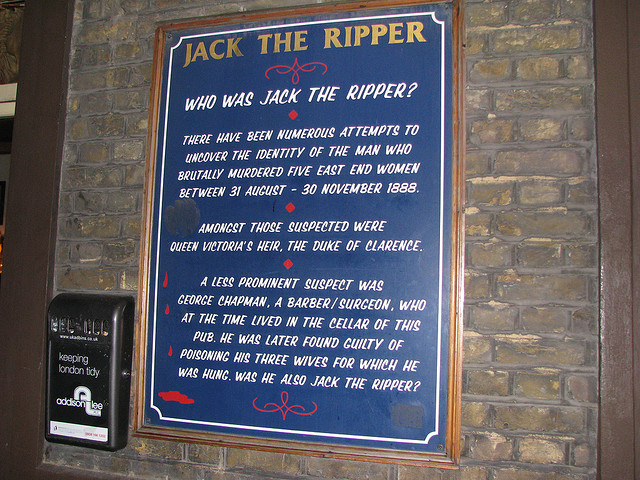
Jack the Ripper was one of London’s most notorious serial killers who targeted prostitutes during the late 1800s in the East End of the city. He was never caught for the so-called “Whitechapel murders,” and speculation continues today as to who this gruesome slasher was. On this walk take the path of Jack the Ripper to witness the spots where his victims took their last breaths. Do the walk at dusk to add an extra element of eerie.
Starting at Liverpool Street Station, go to Thrawl Street, just past Commercial Street, which is near where Mary Jane Kelly, the fifth (and thought to be last) victim was found. Little is known about this victim’s past as the details she told friends and neighbors about her life could not later be verified. As such, Mary Jane Kelly remains as much a mystery as the Ripper himself. From Thrawl Street make your way to Mitre Square, where Catherine Eddowes, the Ripper’s fourth victim, was found on September 30, 1888. Catherine was the second of the killer’s victims that night as he had already taken the life of Elizabeth Stride an hour earlier at Dutfield’s Yard on Berner Street (now Henriques Street).
[social]
Head on to the junction of Court Street and Durward Street where the first victim’s body was found. Mary Ann Nichol’s throat had been slit and it was thought to have occurred only 15 minutes prior to her being discovered, making for a very close escape on the part of the killer. From Durward Street move on to Hanbury Street, which is the location where the body of Annie Chapman, the second victim, was found in a small yard. It is thought that the victim went out around 1:45am to work so that she could afford a bed for the night.
From Hanbury Street loop back towards Spitalfields Market to the Ten Bells pub, a place that was thought to have been frequented by many of the women who fell victim to Jack the Ripper. The pub went through a significant period of promoting its past ties to the Whitechapel murders but has more recently turned its back on the associated tourist trade and is more now akin to your average London pub.
For a more detailed walk itinerary see: www.londonfor free.net/walks/ripper/ripper.php
Legal London
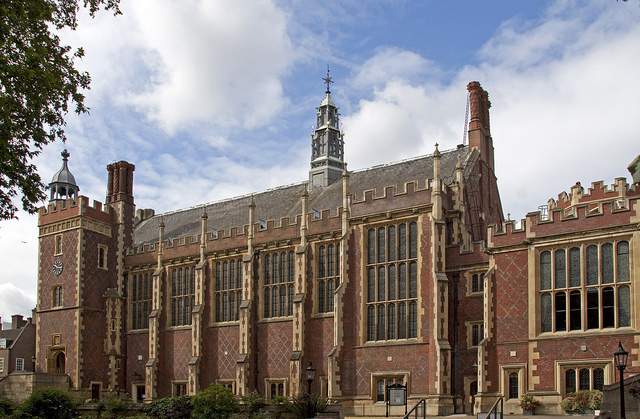
London has a long legal past that stretches back to medieval times, and this walk will bring you into contact with the Inns and courts that make up legal London. Try to visit mid-week as many of the buildings are closed at the weekend.
Starting at Blackfriars, located at 14 New Bridge Street, which was once a prison and place where public floggings took place twice weekly. This method of punishment was popular in Victorian England for a wide range of crimes and was often administered without restriction on the number of lashings given. From the old prison, cross Ludgate Hill to Old Bailey, the street where London’s iconic Central Criminal Court (more colloquially known as the Old Bailey) stands. The court’s most famous trials include those of Oscar Wilde, Dr Crippen, and the Yorkshire Ripper. The building was damaged during the Second World War and was also bombed by the IRA in the 1970s but still holds strong.
Head from Old Bailey to Middle Temple Lane and into Fountain Court, one of the most picturesque of London’s Inns of Court. The Inns of Court are a professional association which all barristers – the men and women in their funny looking wigs and gowns – must be a member of in order to practice law. There were once many Inns, but now there are only four remaining: Lincoln’s Inn, Inner Temple, Middle Temple, and Gray’s Inn. From Fleet Street find Essex Street and the Royal Courts of Justice where non-criminal cases are disposed of, including high profile defamation lawsuits such as the claim by Michael Douglas and Catherine Zeta Jones against Hello! magazine for publishing pictures of their wedding without their consent.
Beyond the Royal Courts of Justice and past Chancery Lane is Lincoln’s Inn, an Inn that can claim several past prime ministers amongst its members, including Tony Blair and Margaret Thatcher. End your walk by looping back to the Royal Courts and cross the road to the Wig and Pen pub. Visit at lunchtime and you may catch a barrister or two thrashing out their court tactics.
For a more detailed walk itinerary see: www.londonfor free.net/walks/legal/legal.php
Mystical London: Harry Potter Tour
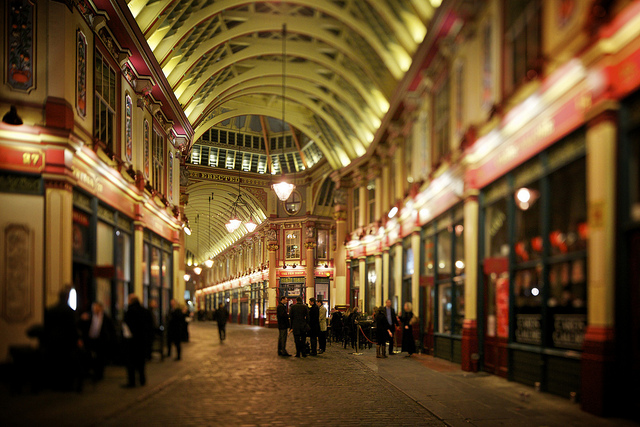
The Harry Potter tour at the Warner Brothers Studios just outside London will set you back £28, plus travel, but with many scenes filmed on the streets of London and others serving as inspiration, get a glimpse of the Harry Potter phenomenon for free.
Starting near Leicester Square, head to New Row and find Hardy’s Original Sweet Shop for a glimpse of a real life Honeydukes. Capitalizing on the success of Harry Potter, you can buy themed sweets featured in the books, including every flavor beans and chocolate frogs. From Hardy’s, head to Cecil Court, just off Charring Cross Road. Filled with antiquities and occult bookstores, it is widely believed that this street spawned the idea of Diagon Alley.
Further on, towards Scotland Yard, locate Scotland Place, which was used to film the visitors’ entrance to the Ministry of Magic in the Order of the Phoenix. Although some props were brought in and have since been removed, it is still possible to identify this spot from the film. Moving on, the interior of Australia House, on The Strand, was used as the location for Gringott’s Bank. The interior is sadly not open to the public, but if you linger long enough, you may be able to catch a glimpse inside.
Next, travel east to Victorian Leadenhall Market where some of the scenes in the movies featuring Diagon Alley were filmed. Pay particular attention to the opticians, which was used as the entrance to the Leaky Cauldron. To complete the tour visit King’s Cross Station to see half a trolley transiting at Platform 9 and ¾.
An excellent and more detailed free tour can be found at: London Discovery Tours
Historic London Pubs
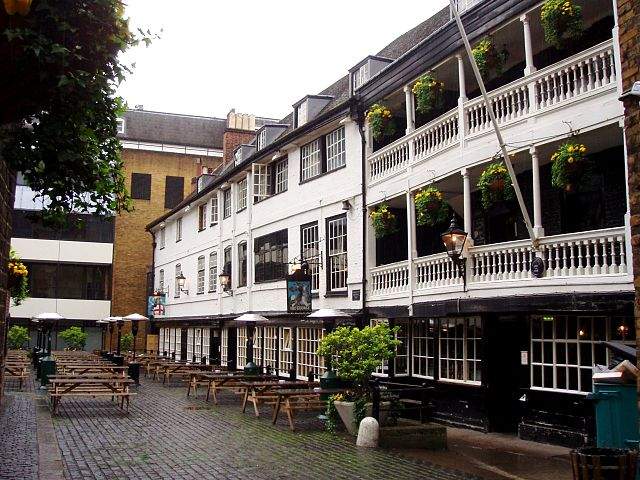
You don’t need to look hard in London to find a bar, but many of these drinking spots are modern creations that could be located in any city around the world. A more authentic taste of London is undoubtedly found in the traditional pubs that litter the city. Even better still, follow this tour to scout out the most historic and notable pubs London has to offer.
Moving from east to west it is possible to plot a pub route across London. Start at Aldgate tube and head to the Hoop and Grapes, which is the site of the city’s last standing timber-framed building. The leaning front forms the original structure that was within yards of being ravaged by the Great Fire of London but managed a narrow escape. After a little English refreshment, cross south of the river to The George Inn on Borough High Street (Tube: London Bridge). The George Inn is another example of one of London’s “last remaining” and is the city’s last galleried coaching inn. As with much of London, it was ravaged by fire, but check out the cobbled courtyard and the original south face.
Follow the riverside walk west and you will shortly come across The Anchor, Bankside. This historic pub is best known as the place where Samuel Pepys watched the Great Fire of London in 1666. Pepys is widely quoted as finding refuge in “a little alehouse on the bankside…and there watched the fire glow.” On to Fleet Street and the Ye Olde Cheshire Cheese (Tube: Blackfriars). This pub has been standing since 1667 and the scent of age is imbued in the walls. The Ye Olde Cheshire Cheese is a warren of a bar that used to be frequented by Dickens and is best visited during the week for a real sense of bar bustle.
Leaving behind the 1600s and stepping into the 1890s, find The Salisbury tucked away behind Leicester Square. The lavish interior reflects London’s Victorian pub era decked in opulent light fittings and etched glass mirrors. The bar was a former gin palace, particularly popular places to buy gin to take away or drink standing up when gin was considered to have medicinal qualities. Try a gin and tonic for the perfect ending to this tour.
Crack the Da Vinci Code

Now that the bulk of the furore sparked by Dan Brown’s internationally best selling book have died down, follow in the footsteps of Robert Langdon without hundreds of other tourists in tow. Start at Fleet Street where Langdon, Sophie Neveu, and Teabing raced to Temple Church on Inner Temple Lane to try and crack the second cryptex. The 12th century church was constructed by the Knights Templar and has a distinctive circular nave. If you’ve taken the legal London walk, you’ll be interested to know this is the church of the Inner and Middle Temple.
After the church, stop at King’s College where, in Brown’s fictional world, his main characters received help cracking the cryptex by a librarian. The room that the scene is based on can be found in the Strand Campus and is the octagonal Reading Room of the Maughan Library. From the library, head to Westminster Abbey, which is a tourist attraction in its own right, regardless of the popularity of the Da Vinci Code. In the Abbey, locate the tomb of Sir Isaac Newton on the north side of the nave, the tomb that Langdon and his friends were searching for.
The story and code cracking continues, but to cover the entire path of the book would take you to Edinburgh and Paris. Perhaps one to add to the travel plans for a future date?
For more details about the sites in the Da Vinci Code see: https://www.sacred-destinations.com/categories/da-vinci-code
Literary London
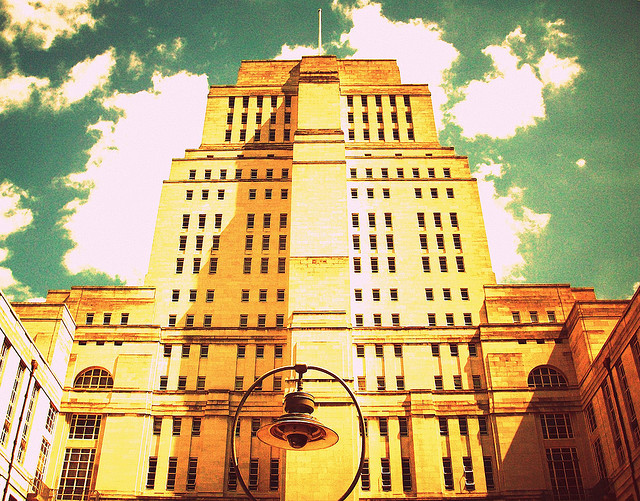
London has been creating, attracting, and inspiring writers for centuries, with many classic authors calling London home at one time or another. Take this walk to see where these literary geniuses lived and gained inspiration.
Using Tottenham Court Road as a starting point, head to Bloomsbury, home to many publishing houses that project modern day writers into print. From there find the corner of Gower Street and Motague Place. Gower Street claims Charles Darwin as a former resident from 1838 to 1842, during which time he worked on The Origin of the Species.
Continue on Montague Place, turning at Malet Street (left) to find the University of London Senate House. Serving as inspiration for George Orwell’s famous novel, 1984, the building operated as the Ministry of Information during World War II and was the basis for the Ministry of Truth, the establishment that secured control in Orwell’s fictional world. From Malet Street, follow the road and turn right to Gordon Square where Virginia Woolf once lived (at number 46), and from there pass a short distance to Woburn Walk, the former home of Irish born William Butler Yeats. Another famous home can be found on Tavistock Square at BMA House, where Charles Dickens lived and wrote many of his most famous works including A Tale of Two Cities, Bleak House, and part of Great Expectations.
For a quick spot of liquid refreshment, head to the Lamb Pub on Lambs Conduit Street. This pub was the meeting place for the Bloomsbury Group, a group of artists and writers, including Virginia Woolf, formed in the 1920, who met and swapped thoughts.
Inspired? Jot down plans for your novel over a pint of traditional ale and take satisfaction in the knowledge that you’ve participated in London life without the cost or hustle of the Olympics.
A more detailed version of this walk can be found at: www.londonforfree.net/walks/writers/writers.php
Check out the following links for more information and resources on traveling in London:
- Find a flight to London
- Check out our new London Travel Guide
- Find a hostel in London
- Read 5 Reasons to Plan Ahead for the London Olympics
- Read 10 Free Things to Do in London
- Click here if you want some help planning your next big trip
<Photos by: RinzeWind, ahisgett, aurelien, Ewan Munro, Pilgrim, hjjanisch
